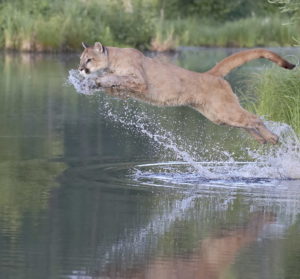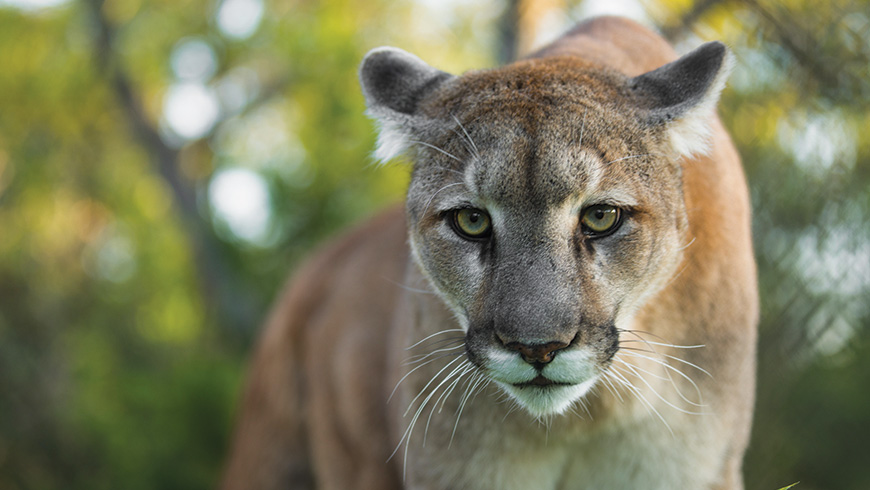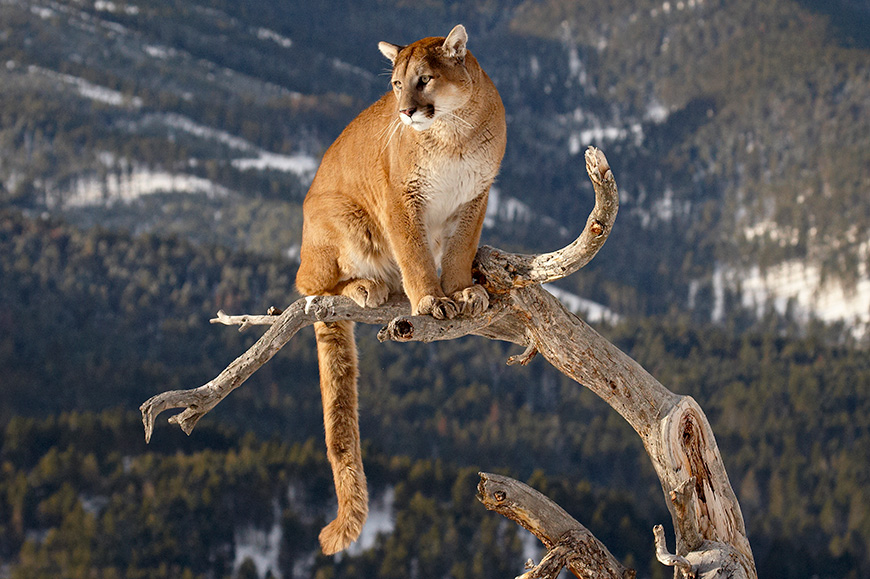Mountain lion. Puma. Panther. Catamount. Wildcat. Cougar.
No animal across the globe is known by so many different names across such a variety of cultures as Puma concolor. In fact, “Guinness World Records” lists some 40 monikers in the English language alone. From ancient South American legend to the front page of local modern-day newspapers, stories of this remarkable feline have inspired a range of emotions from fear to fascination throughout human history.
Cougars are remarkably secretive and lethal stalkers, which gives them a reputation as being both majestic and nightmarish. It is a deadly predator that hunts its prey with silent success while simultaneously prowling the realm of the human psyche in folklore and legend. A symbol of untameable prowess, cougars hold as important a place in our figurative reckoning of what it means to be wild as they do an actual position near the
top of the food chain.
Cougars are primarily known in scientific circles by the name puma and also in 21 of 23 countries throughout their range, which stretches from the southern tip of South American Patagonia to the northern reaches of the Canadian Yukon. However, cougar is the term most often used in the United States and Canada. Mountain lion is a term that can be traced back to its first written use in 1858 in the writings of Colorado’s George Andrew Jackson and is often used interchangeably
in North American discourse.
Though there are several possible etymologies of the word, cougar is most likely derived from the archaic Portugese word, “cucuarana,” which originated from the Tupi, susua’rana. A current derivative, sucuarana, exists in Brazil today.
Though not officially considered one of the “large cats,” which include felines such as the lion, tiger
and jaguar, cougars are sizable felids of the family Felidae and, though relatively populous across their North, Central and South American territories, are rarely seen.
Primarily populating North America’s Western states, confirmed cougar sightings have occurred regularly in some Midwest states, including Michigan, Minnesota, Wisconsin, Nebraska, Iowa and Illinois. In fact, a cougar was shot dead by police in the city limits of Chicago in 2008. Sightings have even been reported as far east as coastal Connecticut, though they were considered extirpated in the Northeast in 2011. And, of course, cougars call the Wood River Valley home as well.
The largest member of the subfamily Felinae, which is native to the Americas, cougars have five retractable claws on their front paws and four on their rear paws. Differentiating them from their larger cousins in the subfamily Pantherinae, of which only the jaguar is native to the Americas, is their inability to roar due to the absence of a specialized larynx and hyoid apparatus.
Generally, cougars will measure 24 to 36 inches at the shoulder with mature males measuring approximately 8 feet in length and females a foot shorter, with a third of the body measurement consisting of the tail. Common weights of these cats vary from 140 pounds for mature males, with females weighing in around 90 pounds. In extreme cases, males may reach weights of over 200 pounds and females, 140.
Researchers have noted that male cougars, or toms, can occupy exclusive home ranges of over 300 square miles. Females inhabit ranges approximately half the size of males. Commonly living eight to 12 years in the wild, some cats have lived as long as 30 years in captivity.
North American cougar populations are estimated at approximately 30,000 individuals, but it is difficult to ascertain an accurate census as they are stealthy, clandestine creatures that are rarely witnessed in broad daylight due to their crepuscular and nocturnal nature of being most active during twilight hours and after dark.
Cougars are ambush predators that prefer topography that features thick underbrush and rocky areas that enhance successful stalking. They are obligate carnivores, which means that they must feed entirely on meat to survive.
The most common cougar prey are ungulates, primarily deer, though they are regularly recorded as killing and consuming elk as well. An adult male will need to take down approximately one deer every other week in order to meet its caloric requirements. Females with maturing cubs may need to kill deer as often as every three days to provide necessary nourishment for their young. Cougars will also hunt prey as small as rodents and insects. With rare exception, cougars do not prefer carrion and will only eat prey they have killed themselves, unlike apex predators such as bears, wolves and wolverines.
Females become sexually mature between 18 months and 3 years old and generally have one to three cubs per litter, although litters of up to six cubs have been reported. Cubs stay with their mothers until the age of 2 at which time they must hunt for themselves and establish their own territories. This period of independence and exploration is often tumultuous and fatal for younger cats as they encounter conflict not only with mature established adults but also with human populations among whom they are forced to roam.
Every winter, cougars, which most often follow deer and elk into the higher reaches of the local mountain chains in the spring, summer and autumn months, descend out of necessity to find prey. Often this pursuit lands them near the banks of the Big Wood River and its many tributaries This is the most likely time for cougar/human interactions or, more significantly, cougar/pet conflicts.
Cougar predation on domestic pets has been a regular occurrence since humans populated the Wood River Valley and built homes along the banks of the river that meanders through the Valley floor. Once the local deer and elk herds have migrated south into the desert for the snowy winter months, many of these feline predators are forced to hunt what remains, predominantly domestic dogs and cats.
Annually, pet owners along the Big Wood River, Warm Springs Creek, and other tributaries report sightings of these tawny, slinking creatures. Many sightings are simply glimpses of a large mammal lurking through the backyard as daylight hours wane. Other times these reports turn gory with family pets bearing the brunt of a full-out violent, and often fatal, attack. Cougars tend to drop from perches above their prey and latch on to the necks of their victims, severing the spinal cord with a powerful bite or chase them down over a short distance and overwhelm their target once they have sunken their retractable claws into fur and flesh.
However, winter is not the only season when cougars and the interests of humans come in conflict. Just ask Matt Christian of Hailey. A few years ago, while bowhunting on a backcountry ridgetop, Christian came face to face with a female mountain lion, which he had surprised.
“It was a windy, noisy day in the woods. I had quietly been working my way down a rocky ridge when I caught movement to my right. Instantly I froze,” Christian reminisced. “Staring at me just 20 feet away was a cougar squatting down, and right away it hissed. I tried to scare it off but it wouldn’t budge. I backed up and began to put space between us and it was then that I saw the cubs hidden behind her in the brush,” he continued. “It was very unsettling.”
Based on recommendations from wildlife officers familiar with cougar behavior, Christian reacted correctly by acting aggressively. Cougars can be intimidated by such behavior, which limits the likelihood of full-out conflict, unlike ursine predators who will more often retaliate when challenged, sometimes with tragic results.
According to Denise McKee’s “Cougar Attacks on Humans: A Case Report,” the rate of cougar attacks on humans has grown as human expansion into historic cougar territories has increased. In fact, from 1890, the year of Idaho’s inclusion as the union’s 43rd state, until 1990, 53 cougar attacks on humans were recorded, including 10 fatalities. In the following
14 years, an additional 35 attacks were documented, including an additional 10 fatalities, an equal number of fatalities recorded in the previous century.
In a story described by early Sawtooth Valley resident and pioneer historian Edna McGown, a family was accosted by a cougar in the late days of the 19th century less than an hour north of present-day Ketchum. McGown recounted that while the father was out collecting wood, the mother had walked a short distance to the creek to fetch water for cooking, leaving her infant son in his bassinet on the front porch in the warm midday sun. When she returned after being away only a few short minutes, the infant was nowhere to be seen. Undeniable cougar tracks were evident in the dirt surrounding the log cabin. The child was never found and the distraught family departed the Sawtooth Valley,
never to return.
Due to the cougar’s effect on local wildlife herds and the concern over human/cougar conflicts, predator control is a policy that has been implemented by most states and provinces throughout the cougar’s territory, from South America north to the Yukon.

Mountain lion or cougar (Felis concolor) jumping into the water, in captivity, Sandstone, Minnesota, United States of America, North America
Hunting, too, has a significant place in the history of P. concolor. Hunting cougars is most often accomplished with the use of hounds since the sizable felines are so difficult to find without the help of canines and their remarkable senses of smell. In our modern day, dogs are outfitted with radio collars that are equipped with radio telemetry systems that allow their handlers to monitor their location on a computer screen or tracking device. Once a dog or string of dogs has found a cougar’s scent trail, they will pursue the cat until eventually forcing the cougar to take refuge in the branches of a tree, where it might avoid the barking and snapping pursuers below. Once the dog handlers and hunter have caught up to the canine, the cat is easily dispatched with the use of a firearm, and the hunt is concluded.
There are many opinions about this style of hunting and not everyone approves. The state of California outlawed cougar hunting in 1990 due to what politicians viewed as an inhumane practice. Since that time, cougar populations have increased, as have human-cougar interactions. Cougar-pet conflicts have also risen, leading some to question the wisdom of this policy, while others suggest that the result of the anti-hunting stance is simply a necessary cost of being a compassionate California community.
Along these lines, it is worth noting that Daniel W. Richards, head commissioner of the California Fish and Game commission, was removed from his job after pictures of his legal harvesting of an Idaho cougar were posted online. Though an entirely legal act, Richards’ actions clearly demonstrated a deep sensitivity among his fellow citizens, sentiments that are not always shared outside the Golden State.
Regardless of one’s opinion regarding hunting, it is true to say that Puma concolor holds a unique position in the food chain surrounding the Wood River Valley, one that often puts it in direct conflict with the human inhabitants who are relatively new to the scene. Sometimes the needs of these impressive cats lead to conflicts. Often such interactions with humans or pets end with the cats being euthanized by the Idaho Fish and Game officers dispatched to the scene of an attack.
And though cougars may rarely be witnessed by the hikers, backpackers, and hunters that commonly traverse our local wilderness, it is undeniable that they are regularly watching us as they serve their role, not only in nature’s food chain, but also in our legends and the human psyche as the representation of what it me



